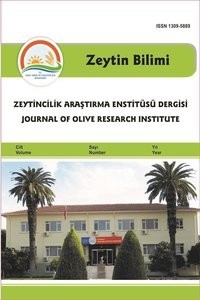İzmir-Kemalpaşa Sanayi Bölgesinde Ağır Metal Kirliliğinin Biyoindikatör Olarak Zeytin (Olea europaea) Bitkisi Kullanılarak Belirlenmesi
İzmir-Kemalpaşa sanayi bölgesinde yer alan fabrikalardan ve otoyol üzerinde seçilen 3 farklı bölgeden ve Kemalpaşa sanayi ve otoyol kenarından 7 km uzaklığında bulunan temiz alandan (kontrol) alınan zeytin (Olea europaea ) yaprağı kullanılarak Cr, Pb, Zn, ve Cu konsantrasyonları belirlenmiştir. Zeytin bitkisinin yaprağındaki Cr, Zn, ve Pb konsantrasyonlarının kontrol grubunun yaprağındaki miktara göre yüksek, Cu konsantrasyonlarının ise sadece çimento fabrikası ve yol kenarındaki noktada düşük olduğu belirlenmiştir. Seçilen alanlarda en yüksek ağır metal kirliliği çimento fabrikası ve yol kenarındaki noktada, en düşük metal kirliliğinin ise kontrol grubu olarak şecilen noktada tespit edilmiştir. Sonuç olarak, zeytin bitkisi kara ekosistemlerindeki kirliliğin kısa vadeli değişimlerini gösterebildiğinden, çalışılan her dört metal elementinin izlenmesinde uygun bir biyoindikatör olduğu sonucuna varılmıştır
Anahtar Kelimeler:
Zeytin, izmir, ağır metal, kirlilik
Determination of Heavy Metal Pollution by Using Olive Plant (Olea europaea) as a Bioindicator in Industrial Zone of Izmir-Kemalpasa
The accumulation of Chromium (Cr), Lead (Pb), Zinc (Zn) and Copper (Cu) and the changes in the accumulation pattern were determinate by using olive (Olea europea) leaf samples collected from three locations near to the factories located in industrial zone of Izmir-Kemalpasa and along highway and from the unpolluted area, where it was 7 km away from the industrial zone and the highway, accepted as the control. The concentration of Cr, Pb and Zn in olive leaves were found to be higher when compared to those of the control group, however, the concentration of Cu was found to be lower in the location near to the cement factory and the highway. The highest values of heavy metal pollution in selected areas were identified in the area near to cement factory and the roadside, whereas the lowest values were obtained in the point selected as the control area. The results of this study showed that olive plant reflected the short term changes of the pollution concluding that olive plant was an appropriate bioindicator in land ecosystems
Keywords:
Olive, Izmir, heavy metal, pollution,
- ISSN: 1309-5889
- Başlangıç: 2010
- Yayıncı: Zeytincilik Araştırma Enstitüsü Müdürlüğü - İZMİR
